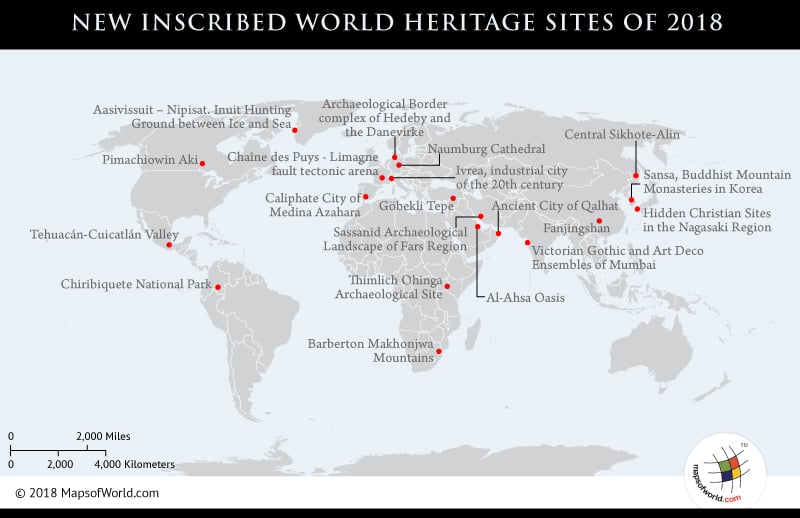What are the ‘New World Heritage Sites’ incorporated in 2018?
UNESCO, in 1972, adopted the ‘Convention Concerning the Protection of the World Cultural and Natural Heritage’, also called the World Heritage Convention, accommodating 193-member countries that are party to it. The convention provides a permanent framework; legal, administrative and financial– for international cooperation in safeguarding mankind’s cultural and natural heritage. It further introduces the notion of World Heritage, the significance of which transcends all political and geographical boundaries. The convention in addition, recognizes the human interaction with nature and the need to preserve a balance between the two, to attain sustainable development.
The member states to the convention, pledges to safeguard and conserve the heritage sites with cultural and natural relevance, depicting exceptional and universal value, within its political boundaries. It, in order to specify the sites, releases the World Heritage Lists, which in turn must meet the specific criteria defined by the World Heritage Committee. The World Heritage Sites, vulnerable to destruction, alteration or abandonment are featured in a separate list published by the World Heritage Committee, as a list of World Heritage Sites in Danger. The Heritage Committee composes of 21 state parties, elected by the General Assembly.
The convention is directed by the ‘Five C’s’ of Credibility, Conservation, Capacity-building, Communication and Communities. It also manages the World Heritage Fund, to determine the prerequisites for the allocation of the funds. The World Heritage Fund, is financed by the member nations and the private organizations and individuals. The financial assistance from the fund can be demanded by the member nations for studies, provision of experts, technicians, skilled labor, training of staff, supply of equipment’s for protection, conservation, rehabilitation and interpretation of World Heritage Properties.
A World Heritage Site, in order to be nominated must be an already stated landmark, possessing unique features in terms of geography, history, or project cultural and physical significance. It can also signify a remarkable accomplishment of humanity and serve as an evidence of the intellectual history on the planet. Ten criteria in a single set was assigned as the framework for the selection of the sites. The nominated sites must meet one of these ten criteria, which have been modified or amended over times, in order to meet the growing demands. The Cultural Sites, include town sites, archeological sites, monumental sculptures and paintings. The Natural criterion is inclusive of those natural areas that portray outstanding examples of earth’s record of life and geological processes, ongoing ecological and biological evolutionary processes and rare natural phenomena. The Mixed kind of Heritage Sites, comprise traits of both Natural and Cultural sites. The ratio of Cultural to Natural site in the World Heritage List is roughly accounted for 3:1. The attainment of a World Heritage Status, is associated with responsibilities and international scrutiny.
Currently, there are 1092 World Heritage Sites, located in 167 countries. The Cultural, Natural and Mixed sites are 845, 209 and 38 respectively. They span across five geographic zones: Africa, Arab states, Asia and the Pacific, Europe and North America and the Latin America and the Caribbean. There arises a need to conserve and protect sites and places of historical importance, as they mark and serve humankind with better understanding of the past trends and social structures. It progresses us towards an ideal society. However, the sites with cultural significance, foster efforts towards a responsible global citizenship, by briefing the people with cultural identities and knowledge. It improves our critical and analytical thinking. Economically, the World Heritage Sites often boosts economies by attracting tourism.
In the middle of every year, UNESCO alters and adds sites to the World Heritage List, meeting the standards set with cultural and natural relevance. Thus in 2018, 20 new sites were incorporated to the existent World Heritage Sites List.
The table given below mentions the sites added in 2018 :
| World Heritage nomination | States Parties |
|---|---|
| Aasivissuit – Nipisat. Inuit Hunting Ground between Ice and Sea | Denmark |
| Al-Ahsa Oasis, an Evolving Cultural Landscape | Saudi Arabia |
| Ancient City of Qalhat | Oman |
| Archaeological Border complex of Hedeby and the Danevirke | Germany |
| Caliphate City of Medina Azahara | Spain |
| Göbekli Tepe | Turkey |
| Hidden Christian Sites in the Nagasaki Region | Japan |
| Ivrea, industrial city of the 20th century | Italy |
| Naumburg Cathedral | Germany |
| Sansa, Buddhist Mountain Monasteries in Korea | Republic of Korea |
| Sassanid Archaeological Landscape of Fars Region | Iran |
| Thimlich Ohinga Archaeological Site | Kenya |
| Victorian Gothic and Art Deco Ensembles of Mumbai | India |
| Barberton Makhonjwa Mountains | South Africa |
| Chaîne des Puys – Limagne fault tectonic arena | France |
| Fanjingshan | China |
| Chiribiquete National Park – “The Maloca of the Jaguar” | Colombia |
| Pimachiowin Aki | Canada |
| Tehuacán-Cuicatlán Valley: originary habitat of Mesoamerica | Mexico |
| Central Sikhote-Alin | Russia |
Know more:
Related maps:


